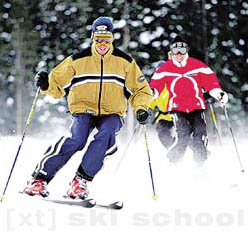|
Ski Bases
Keeping a tuned ski is as important as learning the techniques for skiing. But when tuning the bases, it is important to know a bit of history about the manufacturers. The following material is the combined experience of the Swix wax company and a U.S. Ski Team member.
High performance skis of today have a big advantage over the skis used in the days of Stein Erickson and Pepi Sneider. The most important is the way the base material is made. Today, the base material is developed from ultra-high molecular weight polyethylene. The new material has a higher impact resistance and a lower friction rate, while maintaining a higher degree of wax absorbsion.
The base material is referred to as sintered, because the production method calls for heating a powder substance -- while under pressure -- contained in steel tubes equal to the width of the ski. After a regulated time, the base material is removed and shaved off into appropriate sheets for adhesion to the ski.
The sintered base is always clear, but a carbon / graphite additive can be used to make the base have a better electrical conductivity. This is good in the extreme cold conditions for dissipating the static charges that can slow the ski down and its ability to dissipate water suction at warmer temperatures. Although some experts disagree with the advantages saying that wax, construction and base patterns are more important than the addition of graphite. The carbon base seems to have the majority of the World Cup market.
Alpine Skiing School section in english version of WWW.SKI.BG is based on
"A Guide To Becoming An Expert: From First Time To A Lifetime"
by John Mukavitz Copyright © 1998

|


